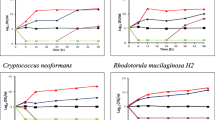Abstract
Thein vitro susceptibilities of propolis and antifungal drugs were determined against some yeasts isolated from patients with superficial mycoses. The agents tested included fluconazole, itraconazole, ketoconazole, terbinafine and propolis. MICs were determined by the broth microdilution technique following National Committee for Clinical Laboratory Standards document M27-P. For allCandida albicans isolates from the patients with superficial mycoses, ketoconazole presented higher (P<0.05) efficiency than that of the other antifungal agents tested. The geometric mean MIC values of antifungal drugs and propolis against the yeasts tested ranged from 0.087 to 12.69 μg/mL and 0.4–0.6 μg/mL, respectively. Propolis also showed an important antifungal activity against the yeasts tested, MIC ranges of the propolis were between 0.01–1.65 μg/mL. Based on these results, propolis requires further investigation as a potential agent for the treatment of superficial mycoses.
Similar content being viewed by others
References
Elder J.V., Joosten L., Verhaeghe A., Surmont I. (1996). Fluconazole and amphotericine B antifungal susceptibility testing by National Committee for Clinical Laboratory Standards broth macrodilution method compared with E test and semiautomated broth microdilution test. J. Clin. Microbiol., 32: 2099–2102.
Espinel-Ingroff A., Kerkering T.M., Goldson P.R., Shadomy S. (1991). Comparison study of broth macrodilution and broth microdilution antifungal susceptibility testing of yeast isolates. Diagn. Microbiol. Infect. Dis., 19: 9–13.
Fernandes Jr. A., Sugizaki M.F., Fago M.L., Funari S.R.C., Lopes C.A.M. (1995).In vitro activity of propolis against bacterial and yeast pathogens isolated from human infections. J. Venom. Anim. Toxins, 1: 63–69.
Fernandez-Torres B., Vazquez-Veiga H., Llova X., Pereiro M., Guarro J. (2000).In vitro susceptibility to itraconazole, clotrimazole, ketoconazole, and terbinafine of 100 isolates ofTrichophyton rubrum. Chemotherapy, 46: 390–394.
Ghisalberti E. (1979). Propolis: A review. Bee World, 60: 59–84.
Greenaway W., May J., Scaysbrook T., Whatley F.R. (1991). Identification by gas chromotography-mass spectrometry of 150 compounds in propolis. Z. Naturforsch., 46c: 11–12.
Haris R. (2002). Progress with superficial mycoses using essential oils. Int. J. Aromather., 12 (2): 83–91.
Holderna E., Kedzia B. (1987). Investigation upon the combined action of propolis and antymycotic drugs onCandida albicans, Herba Pol., 33: 145–151.
Jessup C.J., Warner J., Isham N., Hasan I., Ghannoum M.A. (2000). Antifungal susceptibility testing of dermatophytes: establishing a medium for inducing conidial growth and evaluation of susceptibility of clinical isolates. J. Clin. Microbiol., 38: 341–344.
Kartal M.S., Yildiz S., Kaya S., Kurucu S., Topçu G. (2003). antimicrobial activity of propolis samples from two different regions of Anatolia. J. Ethnopharmacol., 2860: 1–5.
Keskin N., Hazir S., Baser K.H.C., Kürkçüoĝlu M. (2001). antibacterial activity and chemical composition of Turkish propolis. Z. Naturforsch. C, 56: 1112–1115.
Koc A.N., Silici S., Ayangil D., Ferahbaş A., Çankaya S. (2005). Comparison ofin vitro activities of antifungal drugs and ethanolic extract of propolis againstTrichophyton rubrum andT. mentagrophytes by using a microdilution assay. Mycoses, 48: 205–210.
Kujumgiev A., Bankova V., Ignatova A., Popov S. (1993). antibacterial activity of propolis, some of its components and their analogs. Pharmazie, 48: 785–786.
Kujumgiev A., Tsvetkova I., Serkedjieva Yu., Bankova V., Christov R., Popov S. (1999). Antibacterial, antifungal and antiviral activity of propolis of different geographic origin. J. Ethnopharmacol., 64: 235–240.
Metzner J., Bekemeier H., Paintz M., Schneidewind E. (1979). Zur antimikrobiellen Wirksamkeit von propolis und propolis-inhaltsstoffen. Pharmazie, 34: 97–102.
NCCLS — National Committee for Clinical Laboratory Standards (1995). Reference Method for Broth Dilution Antifungal Susceptibility Testing for Yeasts. Document M27-T., National Committee for Clinical Laboratory Standards, Villanova, PA.
Ota C., Unterkircher C., Fantinato V., Shimizu M.T. (2001). Antifungal activity of propolis on different species ofCandida. Mycoses, 44: 375–378.
Park Y.K., Koo M.H., Abreu J.A.S., Ikegaki M., Cury J.A., Rosalen P.L. (1998). Antimicrobial activity of propolis on oral microorganisms. Curr. Microbiol., 36: 24–28.
Pfaller M.A., Rinaldi M.G., Galgiani J.N., Bartlett M.S., Body B.A., Espinel-Ingroff A., Fromtling R.A., Hall G.S., Hughes C.E., Odds F.C., Sugar A.M. (1990). Collaborative investigation of variables in susceptibility testing of yeasts. Antimicrob. Agents Chemoter., 34: 1648–1654.
Pepeljnjak S., Jalsenjak I., Maysinger D. (1985). Flavonoid content propolis extracts and growth inhibition ofBacillus subtilis. Pharmazie, 40: 122–123.
Popova M., Silici S., Kaftanoĝlu O., Bankova V. (2005). Antibacterial activity of Turkish propolis and its qualitative and quatitative chemical composition. Phytomedicine, 12: 221–228.
Silici S., Kaftanoglu O. (2003). Antimicrobial analysis of propolis samples from different regions in Turkey. Uludag Bee Journal, 3 (3): 16–18.
Velikova M., Bankova V., Sorkun K., Houcine S., Tsvetkova I., Kujumgiev A. (2000). Propolis from Mediterranean Region: Chemical composition and antimicrobial activity. Z. Naturforsch. C, 55: 790–793.
Waren N.G., Hazen N.C. (1995).Candida, Cryptococcus and other yeast of medical importance. In: Murray P.R., Baron E.J., Pfaller M.A., Tenover F.C., Yolken R.H., Eds, Manual of Clinical Microbiology, American Society for Microbiology, Washington DC, pp: 723–737.
Author information
Authors and Affiliations
Corresponding author
Rights and permissions
About this article
Cite this article
Sílící, S., Koc, A. & Mistik, S. Comparsion ofin vitro activities of antifungal drugs and propolis against yeasts isolated from patients with superficial mycoses. Ann. Microbiol. 57, 269–272 (2007). https://doi.org/10.1007/BF03175218
Received:
Accepted:
Issue Date:
DOI: https://doi.org/10.1007/BF03175218




